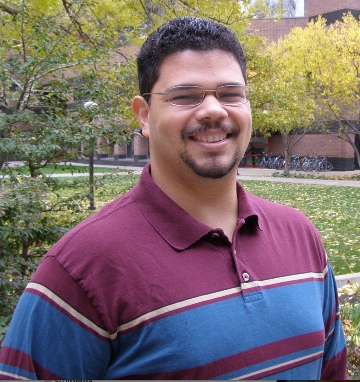
http://www.umn.edu/urelate
612-624-6868
Fall 2018 Colloquia
Mondays, 12:00 - 1:30 pm Elliott Hall S204
December 10 - Catherine Qi Zhao, Computer Science and Engineering
"AI in mental health — machine learning for understanding and identification of autism"
Abstract
Artificial intelligence has gained increasing attention and started to impact healthcare. In this talk, I will discuss the challenges and our work on using AI technologies in mental health. I will discuss recent innovations on data, experiments, and models. As an example, I will elaborate findings that decipher the neurobehavioral signature of autism. I will then demonstrate deep learning models that are able to learn semantic attributes from complex natural scenes and to bridge multiple modalities, leading to breakthrough performance in behavioral prediction and identifying people with autism. I will discuss these technological innovations in the context of clinical applications.
Readings
M. Jiang and Q. Zhao, “Learning Visual Attention to Identify People with Autism Spectrum Disorder”, International Conference on Computer Vision (ICCV), October 2017
S. Wang*, M. Jiang*, X.M. Duchesne, E.A. Laugeson, D.P. Kennedy, R. Adolphs and Q. Zhao, “Atypical Visual Saliency in Autism Spectrum Disorder Quantified through Model-based Eye Tracking”, Neuron, Volume 88, Issue 3, Pages 604-616, November 2015. Featured on the cover. (*Equal authorship)
More papers at https://www-users.cs.umn.edu/~qzhao/publications.html
December 3 - Ann van de Winckel, Physical Medicine and Rehabilitation
"Mechanisms of cognitive multisensory rehabilitation: the use of body awareness/proprioception to improve sensorimotor function after stroke"
Abstract. The key role of somatosensory feedback in motor control, also known as the sensorimotor circle or sensorimotor coupling, is well established in healthy adults. A high percentage of people who have motor deficits in one side of their body after a stroke also suffer from sensory deficits. Sensory deficits after stroke are associated with poorer dexterity, fine motor movements, bimanual coordination and a higher dependency of activities in daily living. Despite the fact that sensory deficits, and specifically deficits related to movement and position sense (proprioception), are regarded as poor prognostic indicators for recovery of function in stroke, few studies have investigated the role of rehabilitation aimed at proprioception (or, more generally, body awareness). Such an integrative treatment whereby proprioception and attention to body awareness is trained during movement could provide an added sensorimotor benefit over the more widely used therapies that focus primarily on recovery of motor function.
The lecture will start with a brief overview of key brain areas involved in the sensorimotor circle. We will cover the impact of brain lesions post-stroke on function, how to assess motor function, proprioception, and body awareness, and how to treat sensorimotor function after stroke with a therapy that focuses on improving body awareness and motor function through cognitive sensorimotor rehabilitation, a therapy that originated in Italy. Moreover, brain reorganization after stroke has mainly been investigated in motor areas. During this lecture, we will also cover the brain areas activated during specific shape discrimination tasks with an MRI compatible robot. Last we will look at how these key brain areas are modulated after cognitive sensorimotor rehabilitation, and how increased activation in these key areas correlate with improved motor function.
November 26 - Sashank Varma (UMN Educational Psychology)
"Theories of Mathematical Thinking Worth Wanting"
Abstract. Cognitive science research has revealed the mechanisms underlying understanding of concrete number and arithmetic concepts. Comparatively little attention has been paid to more abstract concepts. This talk will review cognitive science research, some of it my own, on what mathematical concepts are and how we come to know them. The topics will include how people understand the symbol systems that describe mathematical concepts such as rational and irrational numbers, how people discover insightful solutions to mathematical problems, and how people reason at the interface between mathematics and computer science about the growth of functions and inductive proofs. This work is beginning to capture mathematical thinking as mathematicians themselves describe it.
November 19 - Matt Winn
"The time course of listening effort in listeners with normal hearing and with cochlear implants"
Abstract: Listening effort is an essential part of understanding hearing impairment. In this seminar, we will explore how pupillometry is used to measure the timing and amount of effort needed to understand spoken sentences, with extra focus on the use of contextual cues. When the auditory signal is unclear, greater pupil dilation (typically a sign of increased effort) is observed, and it could persist long after a sentence has been heard, indicating prolonged effort. Context can improve intelligibility and also reduce effort. However, new experiments show that the use of context to reduce effort can be significantly delayed in people with cochlear implants, such that it will be disrupted by listening to the next utterance. Therefore, the well-known benefit of context measured in the clinic and the laboratory might not get a chance to emerge in everyday situations, where talkers speak rapidly and don't give much time to recover from mistakes. Listeners appear to reallocate effort over time in cases where a late disruption is expected, or situations where they expect to listen for a shorter or longer amount of time. This underscores the importance of preparation and post-stimulus processing. A framework is offered whereby the difficulties in speech perception by people with hearing impairment is not limited to mistakes on words, but in the lack of confident prediction, prolonged cognitive processing of those mistakes and how those disruptions interfere with language processing.
 November 12 - Amy Krentzman, School of Social Work, CEHD
November 12 - Amy Krentzman, School of Social Work, CEHD
"The role of gratitude in addiction recovery"
Dr. Krentzman's research focuses on factors that promote the initiation and maintenance of recovery from alcohol and other substance use disorders, particularly the mechanisms of therapeutic change that are precipitated by professional treatment, recovery community organizations, and 12-step programs. Dr. Krentzman studies spirituality, religiousness, forgiveness, and practices such as prayer and meditation as they function in the context of addiction recovery. The focus of Dr. Krentzman's presentation will be her current work on the role of gratitude in addiction recovery. Gratitude has been a dominant theme in 12-step recovery and now a body of experimental research indicates that gratitude interventions have a positive impact on well-being: these studies have been conducted mostly with non-clinical samples (e.g., students, employees). Little work to date has studied the potential for gratitude interventions to support addiction recovery. Dr. Krentzman will provide an overview of the research on gratitude interventions with non-substance use disorder samples and will define key terms such as gratitude practices, state gratitude, and trait gratitude. She will present theories of the relationship between gratitude and successful addiction recovery. She will present the results of her research on the role of gratitude in Alcoholics Anonymous and the results of a gratitude intervention on individuals in outpatient treatment for alcohol use disorders.
 November 5 - Paul Schrater, Psychology and Computer Science
November 5 - Paul Schrater, Psychology and Computer Science
"Controlling your own learning: autodidactic learning architectures"
Human learners express an array of meta-cognitive learning behaviors that are difficult to capture in basic RL architectures. Humans can reason about what is learnable: we make intelligent (and predictably incorrect) choices about time allocation, we predict our likely asymptotic performance on new tasks, and we track our competency in the tasks we train in. We argue that the ability to represent and reason about our own competencies is essential for a rational agent to ameliorate complexity/generalization and time investment trade-offs in learning. We show that these abilities can be represented in a mixed architecture that separately computes predictability and performance, using a mixed architecture: an intrinsically motivated model-based architecture that explicitly computes predictability and competence and an extrinsically motivated Dyna-like model-free architecture that optimizes external reward signals. Computing competence explicitly produces a novel architecture, which we term autodidactic, which arises from a latent variables in a variational Bayes bound on information-theoretic intrinsic motivational terms. By representing and reasoning about their own learning trade-offs, Autodidactic architectures are a better match to human learners and provide another step in the direction of fully autonomous agents.
 October 29 - Megan Gunnar, UMN Institute of Child Development
October 29 - Megan Gunnar, UMN Institute of Child Development
"The biological embedding of early life adversity"
Professor Gunnar will review research on the biological embedding of early life adversity. Her talk will argue that we need to pay attention to our data, not just theory, as there are more pathways for the embedding of adversity than our theories point us towards..
 October 15 - Jonathan Gewirtz (UMN Psychology)
October 15 - Jonathan Gewirtz (UMN Psychology)
"Mental mind-reading in mice: The biology of caring and compassion"
Readings:
"Putting the altruism back into altruism: The evolution of empathy" Frans B.M. de Waal, (2008) Annu. Rev. Psychol. 59:279-300
Abstract. Evolutionary theory postulates that altruistic behavior evolved for the return-benefits it bears the performer. For return-benefits to play a motivational role, however, they need to be experienced by the organism. Motivational analyses should restrict themselves, therefore, to the altruistic impulse and its knowable consequences. Empathy is an ideal candidate mechanism to underlie so-called directed altruism, i.e., altruism in response to anothers's pain, need, or distress. Evidence is accumulating that this mechanism is phylogenetically ancient, probably as old as mammals and birds. Perception of the emotional state of another automatically activates shared representations causing a matching emotional state in the observer. With increasing cognition, state-matching evolved into more complex forms, including concern for the other and perspective-taking. Empathy-induced altruism derives its strength from the emotional stake it offers the self in the other's welfare. The dynamics of the empathy mechanism agree with predictions from kin selection and reciprocal altruism theory.
"Oxytocin enhances observational fear in mice" Pisanky et al., Nature Communications 8:2102, DOI: 10.1038/s41467-017-02279-5
Abstract. Empathy is fundamental to human relations, but its neural substrates remain largely unknown. Here we characterize the involvement of oxytocin in the capacity of mice to display emotional state-matching, an empathy-like behavior. When exposed to a familiar conspecific demonstrator in distress, an observer mouse becomes fearful, as indicated by a tendency to freeze and subsequent efforts to escape. Both intranasal oxytocin administration and chemogenetic stimulation of oxytocin neurons render males sensitive to the distress of an unfamiliar mouse. Acute intranasal oxytocin penetrates the brain and enhances cellular activity within the anterior cingulate cortex, whereas chronic administration produces long-term facilitation of observational fear and downregulates oxytocin receptor expression in the amygdala. None of these manipulations affect fear acquired as a result of direct experience with the stressor. Hence, these results implicate oxytocin in observational fear in mice (rather than fear itself) and provide new avenues for examining the neural substrates of empathy.
October 8 - Chris Barkley, Experimental and Clinical Pharmacology)
"Findings in Experimental and Clinical Pharmacology and How They Relate to Cognitive Science"
Abstract: Many commonly prescribed medications cause cognitive side effects that can be severe enough to lead to pronounced declines in quality of life and consequent discontinuation of an otherwise effective therapy. In this talk, I will review some of our lab's work on two such drugs, the anti-seizure drug topiramate and lorazepam, a benzodiazepine. I will summarize what we have learned about the impairments associated with these medications, describe some risk factors that appear to confer an increased susceptibility to experiencing these deficits, and conclude with a discussion of the process via which these findings may be used to generate concrete predictions that can inform clinical practice.
Related articles:
"The effect of topiramate plasma concentration on linguistic behavior, verbal recall and working memory" Marino et al. Epilepsy & Behavior 24 (2012) 365-372"Patient-focused drug development methods for benefit-risk assessments: A case study using discrete choice experiment for antiepileptic drugs" Holmes et al. Article accepted for publication.
 October 1 - Stephen Guy, Computer Science
October 1 - Stephen Guy, Computer Science
"Computational Modeling of Social Intelligence"
Abstract: Virtual human characters are becoming increasingly common in computer games, simulations, virtual training environments, movies and so on. A key challenge in simulating these virtual humans is understanding how to capture, model, and reproduce realistic social interaction between these virtual agents, and how to better model and understand the real humans with which these virtual agents may interact. In particular, this talk will focus on the development of simple, data-driven models which are faithful to underlying human behaviors, but fast enough to use in real-time computer graphics domains. We will focus primarily on two areas: 1) modeling anticipatory person-to-person collision-avoidance behaviors during navigation and 2) modeling the motion of faces when expressing emotions.
Two relevant papers:
Karamouzas et al. 2014, "A universal power law governing pedestrian interactions", Physical Review LettersHelwig et al. 2017, "Dynamic properties of successful smiles", PLOS One
September 24
"Neural dynamics in primate prefrontal networks: relevance to cognitive control and schizophrenia"
Abstract
The primate prefrontal cortex shares a dense network of reciprocal anatomical projections with other cortical association areas. It has been long thought that communication between cortical areas mediated by these corticocortical pathways is crucial to prefrontal cortical function. However, we are just beginning to understand the physiological complexity of this communication and its relevance to computations performed by prefrontal cortex. Work in our lab has been using electrode arrays in prefrontal cortex and interconnected cortical areas to record the spiking activity of many neurons in prefrontal networks simultaneously. This has allowed us to begin to investigate how temporal correlations in activity may offer clues about the nature of the information communicated between prefrontal cortex and other cortical areas during behavior. More recently, we have started to examine how manipulating NMDA synaptic function pharmacologically distorts neural dynamics and information transfer in prefrontal networks, potentially helping to explain cognitive deficits in diseases such as schizophrenia that are characterized by functional collapse of prefrontal networks. In particular, we are exploring a hypothesis that synaptic insults that increase risk of schizophrenia operate through a common mechanism, which is to fundamentally dysregulate activity timing relationships between neurons communicating in prefrontal networks. Our hypothesis is that the timing defect leads to two negative consequences: (1) it disrupts the effective transmission of information in prefrontal networks, and (2) it subsequently disconnects prefrontal networks through a Hebbian mechanism.
 September 17
September 17
Victoria Interrante, Computer Science & Engineering
Spatial Perception in Virtual Architectural Environments
Abstract
Virtual Reality (VR) technology has the potential to support more effective decision-making in architecture, both with regard to design conceptualization and design review, to the extent that people are able to make equivalently accurate spatial judgments about what they see in VR as they do in the real world. In this talk, I will review some of my group’s more recent efforts to better understand and address the common phenomenon of distance underestimation in VR, along with some of our recent findings related to using VR to answer long-standing questions of interest to architects and designers.
Readings (for registered students):
Impact of Visual and Experiential Realism on Distance Perception in VR using a Custom Video See-Through System
Koorosh Vaziri, Peng Liu, Sahar Aseeri and Victoria Interrante (2017) ACM Symposium on Applied Perception.
A Virtual Reality Investigation of the Impact of Wallpaper Pattern Size on Qualitative Spaciousness Judgments and Action-based Measures of Room Size Perception
Governess Simpson, Ariadne Sinnis-Bourozikas, Megan Zhao, Sahar Aseeri and Victoria Interrante (2018) EuroVR 2018: Virtual Reality and Augmented Reality.




